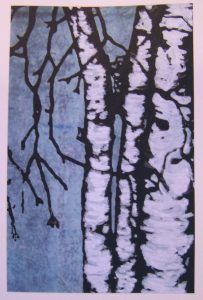Composition and Design – Scale and Proportion
I had been trying to do these Composition and Design posts on a monthly basis but somehow I missed four months. Oops. But here goes the next one on Scale and Proportion. I only have one more post after this so hopefully, I will get it done in September.
Scale and proportion basically refer to size. Scale means size i.e. large scale means big. However, unless you have a standard of reference, the term “big” is meaningless. Proportion means relative size as in size measured against other elements or against some mental norm or standard.
Scale and proportion are closely tied to emphasis and focal point. Large scale makes for an obvious emphasis especially in proportion to other elements of the composition.
The scale of art can be considered in several ways:
• Human scale – consider the scale of the work itself in relation to human size; Unusual or unexpected scale is attention getting. Sheer size does impress us.

• Context – consider the surroundings and the circumstances in which the art is displayed – does the scale of the work affect the meaning in that particular context?
• Internal proportions – scale and size are relative to the overall area of the format of the work; changes in scale within a design change the total effect of the design. The choice of scale and proportion should help to achieve the artist’s intentions.
• Contrast of scale – scale can be used to draw our notice to the unexpected or exaggerated, as when small objects are magnified or large ones reduced. A sudden change in scale draws attention.
• Scale confusion – deliberate change of natural scale to intrigue or mystify the viewer rather than to clarify the focal point – surrealism often uses this technique.

Proportion is linked to ratio. The proportion is judged to be correct if the ratio of one element to another is correct. The ancient Greeks sought to discover perfect proportion and developed the golden rectangle. This has influenced art and design throughout history and is found in growth patterns in nature.
Questions to get you started:
Do you usually make pieces that are small or do you always work in a large format? How does switching to a different size format affect your work? Can you make three separate works about the same subject but vary the scale and proportion in the work? How do you think the viewer will feel about the change in scale/proportion and it’s affect on the meaning of the work?
Can you use contrast of scale or scale confusion in your composition? How does this exaggeration make you see your work differently? Do you use the “golden rectangle” in your proportions? What happens if you deliberately make a piece based on the “golden rectangle”?









12 thoughts on “Composition and Design – Scale and Proportion”
great article. I’d like to see size of the various items mentioned. Are those notecards created from original felted work?
Thanks Kathryn! The note cards are created from original felted work. I’m not sure what items you mean when you are asking for sizes. Most of the photo examples are wall hangings and range in size from 20X24 down to 4×6.
Very informative post, thanks Ruth! The size of your yurt is easily seen when it’s compared to the size of the “tiddler on the roof” – I’d forgotten just how big it is.
Your first photo is a good example for anyone wanting to know how to make landscapes with depth.
I hadn’t heard of the Golden Mean so I’ve certainly learnt something new and interesting today.
(Tiddler is brit slang for child.)
Thanks Lyn! Yes, the scale of the yurt was a good example for human proportions. Glad you learned something 🙂 I learned a new brit slang word!
I had not heard of the Golden Mean. I love Lyns reference to the Tiddler on the roof. 🙂 A lot to consider and think about. Thanks.
You’re welcome! I just keep practicing and considering on all aspects of composition and design. 😀
I had no idea you’d done this series when I posted my question about composition over on the forum last week. Fortunately Lynn’s suggestion to do a search in the blog brought me to them. It will take a while to absorb so much information but thank you. I think they will be really helpful
You are most welcome. I did the series originally for me so I would force myself to learn more about design. It has helped. It is a lot of information but just do one post at a time, work through some of the ideas and then move forward.
Great Post Ruth, lots or great information.
Thanks Ann!
Is Golden Mean the same as Golden Ratio? I’ve heard of it before, and coincidentally have heard it mentioned a couple of times recently. I think my brain finds it hard to process order and prefers chaos and abstract over scale and design, I understand your posts when I read them, but that never translates into practical application when I try.
Yes, the golden mean and golden ratio are the same. I think you’re too hard on yourself because your pieces are well designed, not just a jumble of stuff thrown at the felt.